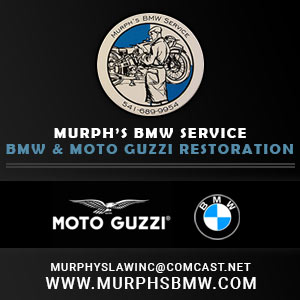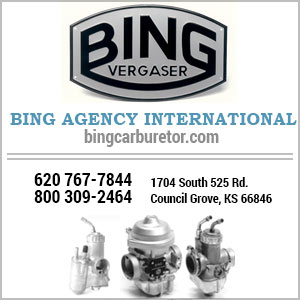Introduction / New Member
Hello,
Just thought I'd introduce myself, I purchased this 1975 BMW R75/6 last year. I've always wanted a BMW airhead, after keeping an eye on the local Craigslist for the past few years I finally picked one up for a reasonable price.
The bike was somewhat rideable when I bought it, I put about 100 miles on it before a slow leak in the master cylinder appeared - apparently the previous owner had "rebuilt" the master cylinder. My guess is that he just replaced the seals but the cylinder bore is pitted, allowing fluid to bypass.
Over the winter I've repaired the gauge cluster (odometer / trip odometer was inoperable) and added a new KatDash LED light insert to replace the heavily corroded original flex PCB with incandescent lights.
I'm currently debating converting the master cylinder over to a handlebar-mounted style or possibly having it sleeved with stainless steel.
I'm also looking at replacing the rusted spokes with stainless steel, new tires, cleaning up the carbs / fixing a small float bowl leak, syncing the carbs, and valve adjustment to hopefully have the bike in decent rideable condition for later this spring / early summer.
Long term I'd like to either replace or fix the gas tank - there are a number of large dents on the left side, and tear the bike down to the frame and have the frame repainted. I'd like to at least get a solid year of riding in to make a better assessment of the mechanical state of the bike before I go too far into fixing aesthetics.
I might start a general build thread in one of the technical forums or perhaps a thread per specific item I'm working on - not sure what's preferred here.
Any thoughts / recommendations
Welcome aboard !
• Leaky master cylinders are a common issue since they are out of sight. Yours look to be way more than pitted cylinder. It appears the reservoir busted at some point in the past. DOT3 and DOT4 fluids are highly corrosive and you can see the results. I would take a VERY close look at the reservoir and the o-rings between the m/c body and reservoir.
• Leaks in the brake m/c can also lead to "iffy" electricals, so you want to spend some time cleaning the starter relay and voltage regulator terminals with hot soapy water and a brush. The corrosive brake fluid also attacks the brass contacts.
• You'll also want to remove the brake m/c and clean the frame so that it can be painted again. You must stop the current on-going corrosion.
• Your idea of the handlebar mounted m/c is good, except for probably having to also fit the RH switch set that goes along with it. ATE brakes can be made to stop, but it takes a lot of work. I'd also highly recommend the addition of "stainless steel" brake lines since your hoses are probably original and you'll want the additional stopping power they afford. There are lots of brake system upgrades, but the extent of brake system rework highly depends upon your riding area. More later if needed.
• In the carbs you might as well order new float bowl gaskets, new floats, and new float needles. Those are all mandated updates. Then check the diaphragms for rips and holes. Older bikes also enjoy having their rubber inlet hoses replaced. Use only the high octane fuels with built-in cleansers for best results.
• While the carbs are off, you'd do well to remove the engine top cover and the LH air filter housing. A simple job consisting of only 3 screws. The reason is that mice are famous for building elaborate homes inside the large protected space. It's an opportunity to prevent some self-inflicted head-on-wall banging since the symptoms are always VERY strange and VERY hard to diagnose.
• Another often over-looked renewal point is the plug wires and plug caps. The wire MUST be non-suppression metal core plug wire, which can be hard to find. Caps are typically replaced with 5K Ohm NGK plug caps off Amazon. New NGK BP7ES plugs also help.
I agree with putting some miles on the bike before spending great gobs of money. You'll usually find the bike rewards the owner 10 times over with just a little fiddling and $50 worth of parts. Keep us informed about how it goes, and happy riding. Hope this helps.
Owning an old Airhead is easy.
Keeping an old Airhead running great is the true test.
Welcome to Airheads. I second what Wobbly said. Personally I'd find the master cylinder leak. It may well only be an "O" ring-much cheaper than a new cylinder. Then I'd go for a ride.
You did not indicate where you live, but if you can get to Carolina in June, Gathering of the Clans is a great opportunity to meet other Airheads and while not a tech day as such, always a lot of tech knowledge and at least a few machines being fixed.
Bob
Congrats on your "new" bike. Address potential "safety" aspects once you have it rideable - wheel bearings / steering bearings / brakes / final drive / tires.
Sometimes the under tank cylinders are salvageable, sometimes not....I repaired a 17mm dual disc under tank reservoir years back on a R100S....it had corrosion in the bore and very minor pitting from years of sitting. I used some fine Crocus Cloth, wrapped around a dowel and carefully worked it with some light solvent. It took a while but the bore ended up clean, pit-less and shiny. New seals/ piston / O-rings and a set of stainless steel lines had it working as it was supposed too....which is really not that great. I think they later went to 14mm bores which were an improvement. I pull my fuel tank at least once a year to inspect reservoir (and drain fuel tank completely - water can sit in bottom). My biggest problem was bleeding out the brake cylinder once done....I "bench bled" it, but had an airlock which gave me fits.....I ended up using a small syringe, full of brake fluid, and injected it into the fitting in the reservoir a few times. That finally did the trick and "got the juice's flowing".
New member from Nashville/Goodlettsville TN, like many of you had dreams of owning an airhead and I finally found one.
I’ve grown up with air cooled VW’s so this was a no brainer as far as what bike to look for.
Found this 1984 R100RT in Memphis. It needs a few things but overall it was in decent shape.
New tires, valve set and plugs so far. Needs carbs renewed I’m sure as it’s surging just a bit at 70+.
Great bike I’m loving it so far.
Good looking bike, I picked up a r75/6 1975 model in December. Great bike and it’s why I joined up here. I would love to see a build thread on the bike. I’m with you though not sure what’s the preferred method of posting around these part.
Thanks for the post
welcome to your new family.
I 'll suggest that you find 1 or 2 local tech sessions to attend in your lo-cal and discover the in's n out's of airhead wisdom. lot's of folks to help you along this sickened path.
many have said what can be done. the rebuilt M/C should have been re-sleeved as won said the old was probably pitted badly. i did mine because I wanted to stay w/ the type pushing juice to 2 4pot brembos. there is a trick to installing the seal kit hopefully the PO did this correctly. best to ask him . also the 2 0-rings are an issue to find and they MUST BE ..... EPDM type 0-ring material. they can NOT be regular store bought viton, buna etc....... only EPDM will hold up to brake fluid !
I used some fine Crocus Cloth, wrapped around a dowel and carefully worked it with some light solvent. It took a while but the bore ended up clean, pit-less and shiny
.
a better idea imho, is to find a 1/4" steel rod, use a hacksaw to cut down the end a slit so i 1" piece of cloth backed sand paper/ crocus/ cloth sanding media could slip down the slit, use a drill and not a dowel.
you might try this, mine was too pitted and I wanted to do this process ONLY ONCE. hence the SS re-sleeve.
contact Mark
Re-sleeves BMW motorcycle master cylinders:
Machine shop still in business,
Still sleeves in stainless only
Phone number did change to:
413-789-8665
800 528 5235
Address is still the same though
Mark Frappier
82 Mountainview Street
Agawam, MA 01001
Another often over-looked renewal point is the plug wires and plug caps. The wire MUST be non-suppression metal core plug wire, which can be hard to find. Caps are typically replaced with 5K Ohm NGK plug caps
I beg ... not really .... to differ. the solid 'wire core' is a stock item @ any flaps.
flaps = Friendly Local Auto Parts Store
same with the ends. be sure that you solder the ends to the coils side by pushing the wires thru the triangle hole, splaying them, solder and trim by sanding the barbs smooth. see pics.
there are a host of online shops that sell the 5KΩ caps besides Cr'amazon' !
those ends screw into the plug wires so that is a solid contact. measured w/ a VOM you'll get 5KΩ resistance. between the 2 wires end to end w/ a VOM & coil should be something like ....
9. TESTING coils & ignition caps:
a. The QUICKIE test is to remove the spark plug cap from both the left and the right cylinder
spark plugs, and then insert a long ohmmeter test lead into one cap, and the other, at the
same time. You are then measuring the total resistance of the spark plug caps and the coil (s). The reading MUST NOT be infinite or in the hundreds of thousands or higher....that
signifies an open coil, open cap, bad wiring, or some-such thing.
The reading SHOULD be
13K to 18K ohms on the POINTS bikes;
and up to 30K on the bikes with the original molded non-separable spark plug cap cables.
- 27 Forums
- 1,890 Topics
- 10.8 K Posts
- 5 Online
- 5,919 Members





